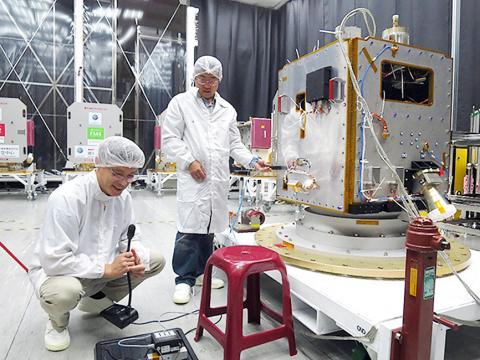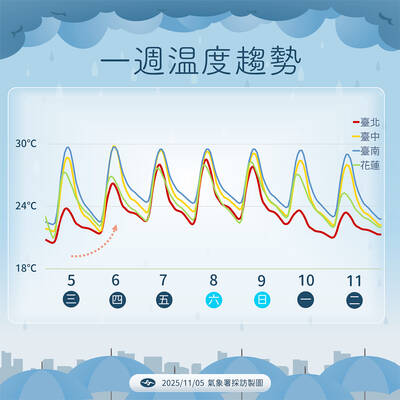The nation’s second domestically developed satellite, Triton (獵風者), is slated to be launched in the second half of 2021 by French firm Arianespace at a base in French Guiana, the National Space Organization (NSPO) said on Friday.
Dubbed the “Wind Hunter,” the satellite will be tasked with gathering data about sea wind and working with the Formosat-7 constellation to advance the nation’s weather forecasting capacity, NSPO Deputy Director-General Yu Shiann-jen (余憲政) said.
The six-satellite Formosat-7 constellation — a Taiwan-US collaborative program — was launched by the US company SpaceX with other foreign satellites from the Kennedy Space Center in Florida on June 25.

Photo provided by the National Space Organization
The nation’s first domestically developed satellite Formosat-5, a remote-sensing satellite, was also launched by SpaceX on Aug. 25, 2017 from the Vandenberg Air Space in California.
For the Triton launch, two companies — Arianespace and another foreign firm — competed for the bid, Yu said.
Most of Triton’s critical components and payload instruments were developed by Taiwanese personnel, with its ratio of indigenous development reaching 87 percent, 9 points higher than for Formosat-5, he said.
Its payload instrument — the Global Navigation Satellite System Reflectometry (GNSS-R) — as well as other critical components, such as the onboard computer, the power control unit, the GPS receiver and a fiber-optic gyro, were developed by NSPO personnel, Yu said.
The cubic satellite, measuring about 280kg, is equipped with a deployable solar panel on one side, according to Triton’s project description on the NSPO’s Web site.
It will be launched with other satellites from an orbit of 500km to 600km from the ground, with an inclination angle of no smaller than 24°, while the actual parameters should be confirmed along with other satellites, the NSPO said.
Some of the techniques used in developing Triton were an improvement on those used in Formosat-5, and they would be further advanced when developing the nation’s next satellite program, Formosat-8, a remote-sensing satellite, Yu said.
Additional reporting by CNA

Three Taiwanese airlines have prohibited passengers from packing Bluetooth earbuds and their charger cases in checked luggage. EVA Air and Uni Air said that Bluetooth earbuds and charger cases are categorized as portable electronic devices, which should be switched off if they are placed in checked luggage based on international aviation safety regulations. They must not be in standby or sleep mode. However, as charging would continue when earbuds are placed in the charger cases, which would contravene international aviation regulations, their cases must be carried as hand luggage, they said. Tigerair Taiwan said that earbud charger cases are equipped

Foreign travelers entering Taiwan on a short layover via Taiwan Taoyuan International Airport are receiving NT$600 gift vouchers from yesterday, the Tourism Administration said, adding that it hopes the incentive would boost tourism consumption at the airport. The program, which allows travelers holding non-Taiwan passports who enter the country during a layover of up to 24 hours to claim a voucher, aims to promote attractions at the airport, the agency said in a statement on Friday. To participate, travelers must sign up on the campaign Web site, the agency said. They can then present their passport and boarding pass for their connecting international

UNILATERAL MOVES: Officials have raised concerns that Beijing could try to exert economic control over Kinmen in a key development plan next year The Civil Aviation Administration (CAA) yesterday said that China has so far failed to provide any information about a new airport expected to open next year that is less than 10km from a Taiwanese airport, raising flight safety concerns. Xiamen Xiangan International Airport is only about 3km at its closest point from the islands in Kinmen County — the scene of on-off fighting during the Cold War — and construction work can be seen and heard clearly from the Taiwan side. In a written statement sent to Reuters, the CAA said that airports close to each other need detailed advanced

UNKNOWN TRAJECTORY: The storm could move in four possible directions, with the fourth option considered the most threatening to Taiwan, meteorologist Lin De-en said A soon-to-be-formed tropical storm east of the Philippines could begin affecting Taiwan on Wednesday next week, the Central Weather Administration (CWA) said yesterday. The storm, to be named Fung-wong (鳳凰), is forecast to approach Taiwan on Tuesday next week and could begin affecting the weather in Taiwan on Wednesday, CWA forecaster Huang En-hung (黃恩鴻) said, adding that its impact might be amplified by the combined effect with the northeast monsoon. As of 2pm yesterday, the system’s center was 2,800km southeast of Oluanbi (鵝鑾鼻). It was moving northwest at 18kph. Meteorologist Lin De-en (林得恩) on Facebook yesterday wrote that the would-be storm is surrounded by